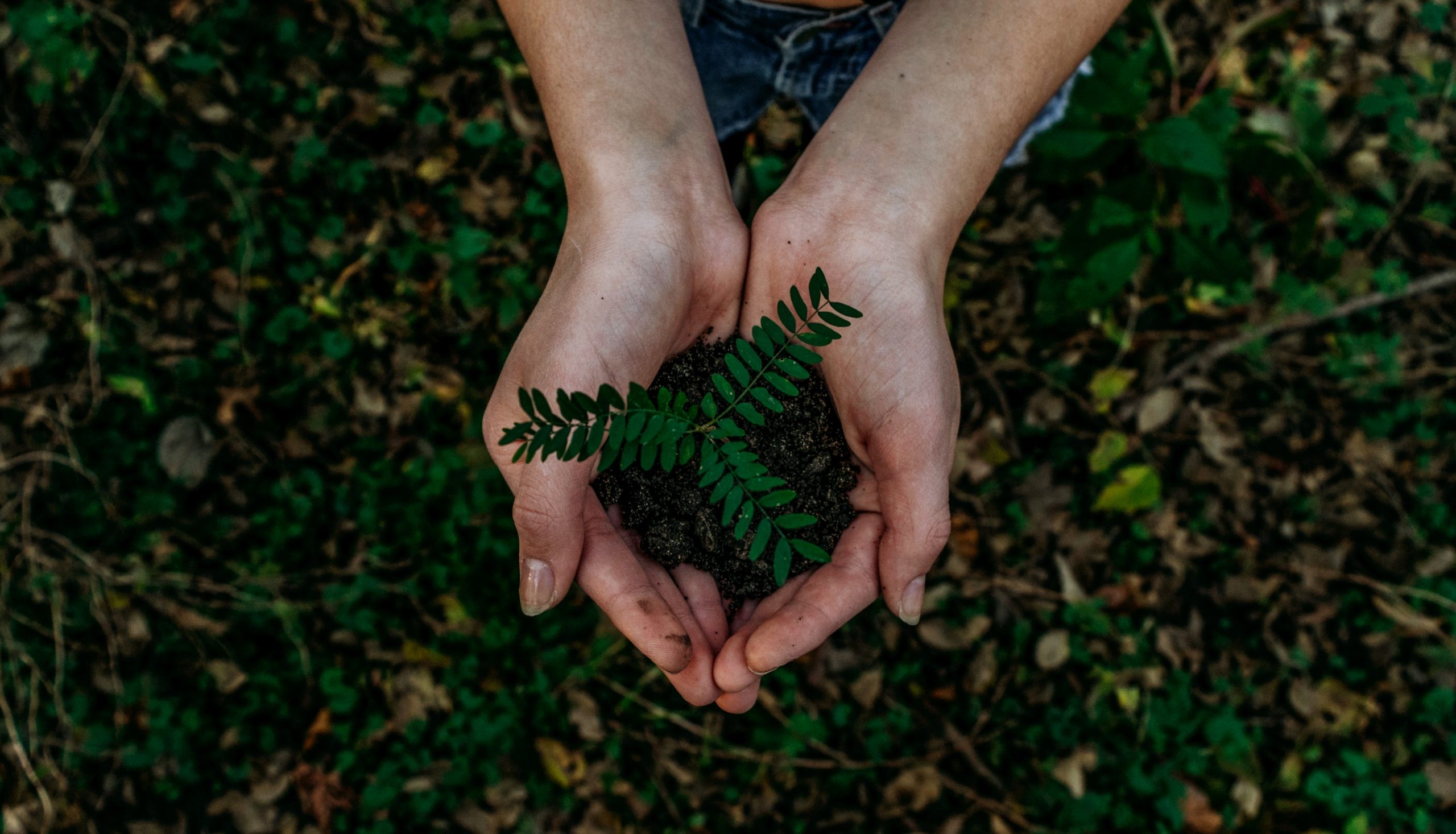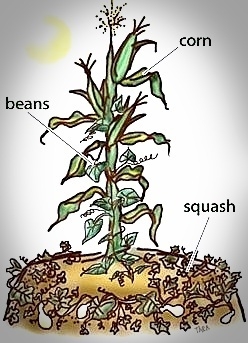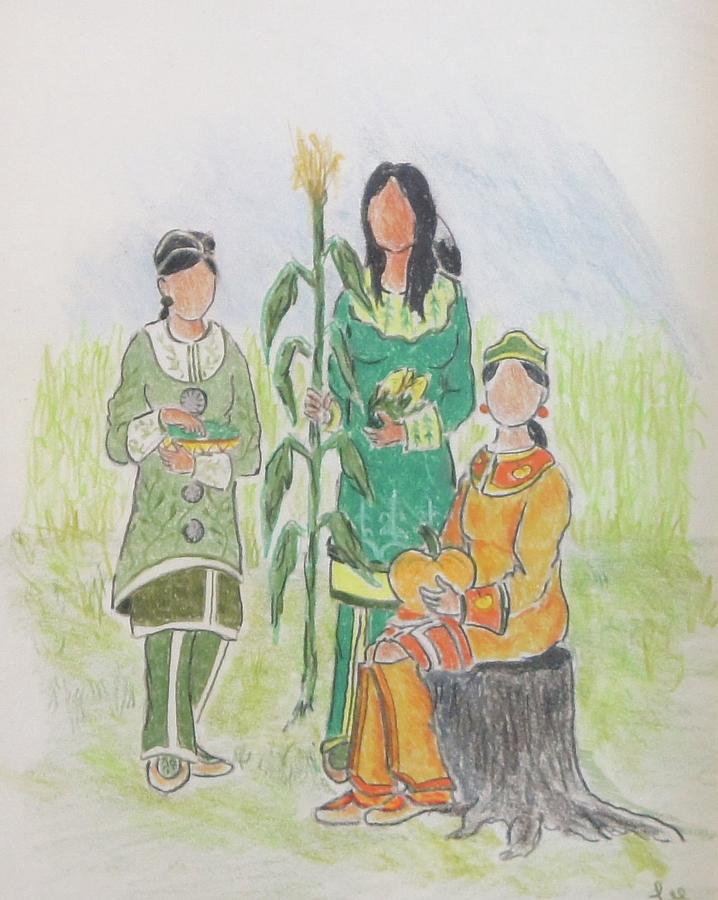A Communion for Earth Day

Suppose you held out your hand, and I – or any member of your community or parish or friendship circle – placed into it three gifts: one corn kernel, one speckled bean, one pumpkin seed. You would then hold in your hand the Indigenous people’s “three sisters” which Native American writer and professor of botany, Robin Kimmerer reminds us in Braiding Sweetgrass, “feed the people, feed the land, and feed our imaginations, telling us how we might live.”
For thousands of years, it had been women who planted these three sisters, always together, in each square foot of earth. They planted the corn first and, as it grew in height, they added the bean which plumped and stretched into deep roots and slender sprouts. Finally, they planted the squash seed, and, in time, it, too, began to extend itself upward and outward to sprawl across the loamy ground. As the corn grew taller, the bean tendrils and vine wrapped around and climbed up its stalks. The squash took a horizontal route instead, and on the way grew large umbrella leaves that shaded the soil and sealed in moisture around itself and its sister corn and bean. Robin Kimmerer, as both a scientist and one of those Indigenous women, celebrated the metaphoric meaning in what she was seeing: “Together their stems inscribe what looks to me like a blueprint for the world, a map of balance and harmony.”

The beans did not hamper the corn’s growth. Instead, their leaves provided dappled shade for the corn stalks, and their roots, growing much deeper than the corn’s, supplied the necessary nourishing nitrogen. The corn, in turn, kept the beans high off the ground, into the light, and far from the hungry predators that would ravish them if they sprawled on the ground below. The squash took care of limiting weed growth and preserving moisture. Each plant, in its determination to promote its own success, was also contributing to the flourishing of the whole. Again, the author ascribes a larger meaning to what she sees happening:
The way of the Three Sisters reminds me of one of the basic teachings of our people. The most important thing each of us can know is our unique gift and how to use it in the world. Individuality is cherished and nurtured, because, in order for the whole to flourish, each of us has to be strong in who we are and carry our gifts with conviction so they can be shared with others. Being among the sisters provides a visible manifestation of what a community can become when its members understand and share its gifts. In reciprocity, we fill our spirits as well as our bellies.
Agribusiness, as we know, does not follow this model. Corn, beans, squash grow separately in acres of monoculture rows needing artificial fertilizers, gallons and gallons of pumped in water, herbicides and pesticides to survive. The three sisters, on the other hand, fertilize each other symbiotically; their diversity limits the pest infections; their mutual protection reduces the need for watering and tending. Theirs is a model the earth desperately needs, one which promotes a cooperative relationship between Western science and Indigenous knowledge, one in which “the intellectual monoculture of science will be replaced with a polyculture of complementary knowledges. And so all may be fed.”
All may be fed in body – and in spirit.
Feeding the spirit as well as the body brings us back to our own quest for leadership and inclusion in ministry in the monoculture that is the Catholic hierarchy. What would a “polyculture” of knowledge bring forth to an institution that is so often fed by artificial fertilizers distilled from irrelevant and irreverent traditions, by waters so polluted by prejudices and fears that they no longer nurture, and by the pesticides of injustice and exclusion long past their due date and yet persistent in trying to keep away the beneficial, nourishing, and new life around us?
Well, as Robin Kimmerer reminds us, there is a “fourth” sister, too – or a brother or a person of any gender – who plays a crucial role.
That person is us. We are as critical to the three sisters as they are to us. It is we who turn over the old soil, plant the new seeds, scare away the crows, tend the crops, and harvest its bounty. We are part of the earth’s reciprocity. It gives; we give. It takes, and we take. Couldn’t that be part of the reciprocity of the Church, too? We bemoan what it fails to give, but what have we failed to give? As surely as we are not going to give up on the earth, perhaps we should not give up on the Church either. Let’s keep planting and tending and weeding and scaring away crows (We certainly know who they are!). And let’s insist on participating in – and defining – the harvest. As Robin Kimmerer reminds us:
Alone, a bean is just a vine, squash an oversized leaf. Only when standing together with corn does a whole emerge which transcends the individual. The gifts of each are more fully expressed when they are nurtured together than alone. In ripe ears and swelling fruit, they counsel us that all gifts are multiplied in relationship. This is how the world keeps going.


4 Responses
Ellie, so perfect. Before my dance aerobics this morning, two participants were debating this book; I am so glad to have your take on it! And the analogy is perfect.
Neuroscience exposes the falsehood of patriarchal gender ideology and supports the ordination of women:
Nurturing Our Humanity: How Domination and Partnership Shape Our Brains, Lives, and Future
Riane Eisler & Douglas P. Fry
Oxford University Press, 2019
https://global.oup.com/academic/product/nurturing-our-humanity-9780190935726
Ellie, this is a simply splendid use of “Braiding Sweetgrass” to reflect not only on the environmental crisis but also on Catholic women’s exclusion from ordination. May women be braided fully and soon into a healthy Catholic environment! Thank you so much.
This is a really wonderful posting, Ellie. You do a great job distilling the key points of Kemmerer’s discussion of the Three Sisters, and you underline the metaphor connecting it to the ways of the hierarchy in dealing with women. Thanks for your work on this, and for bringing Native cultures and especially Native women into the discussion.